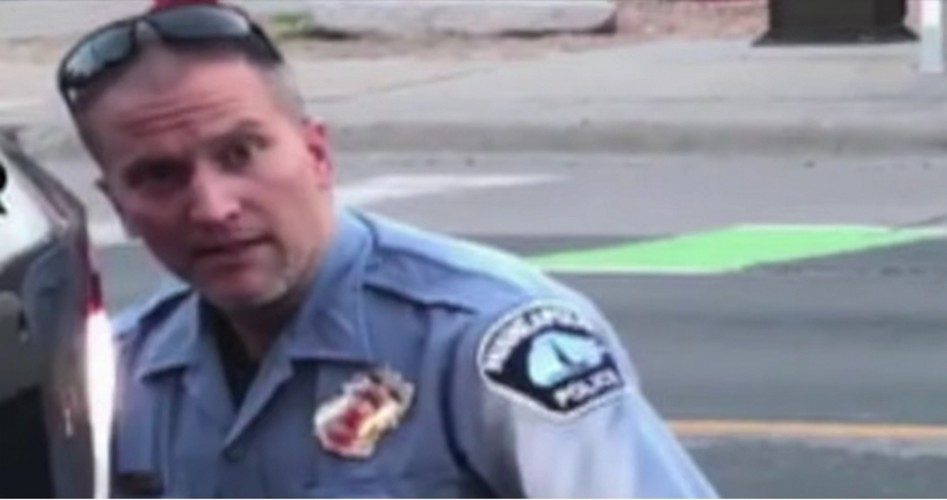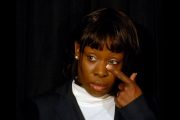
Derek Chauvin, the police officer who kept his knee firmly planted in the neck of George Floyd until he was either dead or near-death, has been charged with third-degree murder.
According to the allegation made by the Hennipin County Attorney’s Office on Friday, “The defendant had his knee on Mr. Floyd’s neck for 8 minutes and 46 seconds in total. Two minutes and 53 seconds of this was after Mr. Floyd was non-responsive.” (Emphasis added.)
Hennepin County Attorney Mike Freeman explained that, after gathering evidence that included video from a bystander’s cell phone, body camera footage, statements from witnesses, and a preliminary report from the medical examiner, “We felt in our professional judgment that it was time to charge and we have done it.”
Additional charges are expected to brought against the other officers at the scene.
The criminal complaint cites the autopsy that Floyd did not die from strangulation alone, but rather a combination of being restrained along with Floyd’s underlying health conditions, including heart disease and hypertension.
According to Minnesota law, murder in the third degree is perpetrating [an] eminently dangerous act and evincing depraved mind, without regard to human life. First degree murder in Minnesota requires premeditation and intent, while a second-degree murder charge necessitates intent. The prosecutor evidently did not believe that Chauvin intended to cause Floyd’s death, but that his actions were both dangerous and deliberate, and resulted in the man’s death.
Chauvin was also charged with manslaughter in the second-degree, which is defined as culpable negligence creating unreasonable risk. The first charge of murder in the third degree carries a sentence of up to 25 years in prison, while the second charge could result in a prison sentence of up to 10 years.
The charge states, “That on or about May 25, 2020, in Hennepin County, Minnesota, Derek Michael Chauvin caused the death of George Floyd by his culpable negligence, creating an unreasonable risk and taking a chance of causing death or great bodily harm to George Floyd.”
According to the statement of probable cause, someone — unidentified — called 911 and reported that a man bought merchandise from Cup Foods at 3759 Chicago Avenue in Minneapolis with a counterfeit $20 bill. At 8:08 p.m., Minneapolis Police Department officers Thomas Lane and J.A. Kueng arrived with their body-worn cameras activated and running. The officers learned from store personnel that the man who passed the counterfeit bill was parked in a car around the corner from the store.
Officers approached the car, with Lane on the driver’s side and Kueng on the passenger side. Three people were in the car, including Floyd. Officer Lane pulled his gun and pointed it at Floyd’s open window and demanded Floyd show his hands. Floyd complied by putting his hands in the steering wheel, whereupon Lane put his gun back in his holster. Lane ordered Floyd out of the car, and pulled him out of the car. Lane handcuffed Floyd, who actively resisted being handcuffed.
Floyd was then compliant, and walked with Lane to the sidewalk and sat on the ground at Lane’s direction. Lane obtained Floyd’s name and told him that he was being arrested for passing the counterfeit bill. The two officers then escorted Floyd toward their squad car, at which point Floyd stiffened up and fell to the ground. He then told the officers he was claustrophobic.
It was then that Chauvin and Officer Tou Thoa arrived in a separate squad car. Floyd struggled with officers by intentionally falling down, refusing to get into the car. Standing outside the car, Floyd told the officers that he was having trouble breathing. Officers Chauvin, Lane, and Kueng tried to get Floyd into the car from the passenger side.
According to the complaint, Chauvin pulled Floyd out of the passenger side of the car, whereupon Floyd went to the ground face down. Kueng held Floyd’s back and Lane held his legs, while Chauvin placed his knee in the area of Floyd’s head and neck.
Floyd repeatedly told officers, “I can’t breathe,” and “Mama,” and “please.”
Lane asked, “Should we roll him on his side?” but Chauvin responded, “No, staying put where we got him.” Officer Lane said, “I am worried about excited delirium or whatever,” but Chauvin retorted, “That’s why we have him on his stomach.”
Floyd stopped moving at 8:24:24, about five minutes after Chauvin had placed his knee on Floyd’s neck. About one minute later — 8:25:31 — Floyd quit speaking or breathing. Lane suggested they roll him over on his side, while Kueng checked for a pulse and said he could not find one.
But none of the officers moved from their positions, and it was not until 8:27:24 that Chauvin removed his knee from Floyd’s neck, when an ambulance arrived. The officers assisted in placing Floyd on a gurney, and the ambulance left the scene. Floyd was pronounced dead at Hennepin County Medical Center.
The autopsy revealed no physical findings supporting a diagnosis of traumatic asphyxia or strangulation, but that Floyd had underlying medical conditions of coronary artery disease and hypertensive heart disease. The medical examiner concluded that the cause of death was a combination of being restrained by the police and his underlying health conditions, as well as any potential intoxicants in his system.
The charge concluded that police are trained that the type of restraint used on a subject in a prone position “is inherently dangerous.”
In a constitutional republic, decisions on whether to charge any person of a crime should be made based on the merits of each individual case, according to the existing statutes, in the best judgment of the prosecutor. Public opinion should have no bearing whatsoever with this decision — either way.
If a prosecutor files charges against a defendant to please the public, then we do not have a republic, but rather mob rule. It is no better than a lynching. On the other hand, failing to file charges against a person who has perpetrated a crime because of who the person is, for political reasons or celebrity status, or as a response to public opinion, is no better. In this case, many commentators well known as supporters of the police have found Chauvin’s actions criminal.
But, again, such decisions should not be based on public opinion, but rather through procedures of due process. While we can all have and express an opinion on what should be done in this case, or any other criminal cases, every person deserves due process of law. The burden of proof in this case, as in all other criminal cases, is on the prosecutor to prove his case before a jury beyond reasonable doubt.
In criminal cases, the purpose of due process is not to protect the guilty who should be convicted, but the innocent who should not be. If Chauvin is found guilty, he should be punished to the full extent of the law.
We can all watch the videos and be outraged at the actions of the police officers, especially Chauvin’s. However, the burden of proof will not be that a jury is outraged, but rather can the state prove, beyond reasonable doubt, that Chauvin perpetrated an eminently dangerous act and evinced a depraved mind. They do not have to prove that Chauvin intentionally killed Floyd, but rather that his action was dangerous and that he evinced a depraved mind (understood that his actions were dangerous), and that his actions were taken “without regard for human life.”
For conservatives who ordinarily support the local police forces of our nation, we must also understand that no person is above the law. In the case of police officers, they are given — and should be given — a certain amount of power beyond that which we would give an average citizen. However, with that power comes the responsibility to exercise it properly. Going beyond one’s legal power and authority should not be allowed in our society.
What we should not allow is for this case to be used for political purposes, or other agendas besides justice.
We can all hope for justice for both the victim and the defendant in this case, and in all cases.
Photo of Derek Chauvin: YouTube
Steve Byas is a university instructor in history and government and the author of History’s Greatest Libels. He may be contacted at [email protected].



